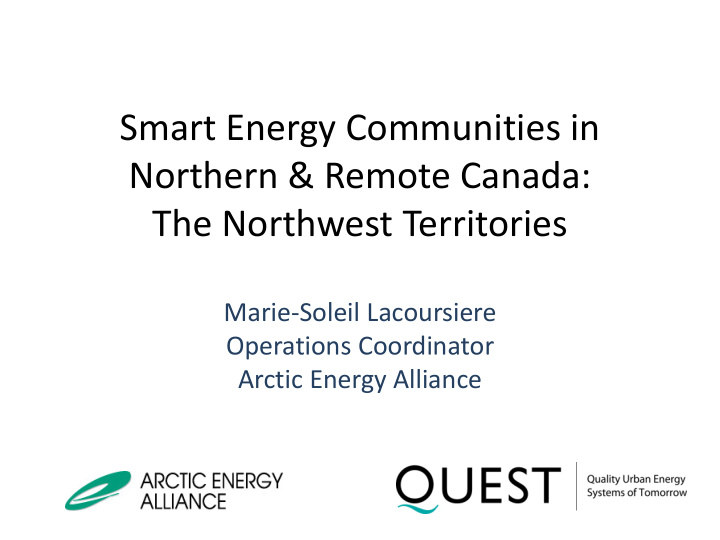



Smart Energy Communities in Northern & Remote Canada: The Northwest Territories Marie-Soleil Lacoursiere Operations Coordinator Arctic Energy Alliance
Northwest Territories (NWT)
Energy in the NWT • Hydroelectricity on a portion of the territory only • Diesel generators in communities normally about 30-35% efficient • Subsidized rate in non-hydro zone • Fuel supplied via truck on road / ice road, or barged • Biomass: easily available in some regions only • Wind: some challenges • Solar: darkness/daylight cycle
Territorial Energy Strategies • NWT Biomass Strategy (2012-2015) – incl. territorial funding for wood pellet initiatives and local harvesting of biomass for centralized heating • NWT Greenhouse Gas Strategy (2011) – incl. territorial funding for rebates towards purchase of qualifying energy efficient appliances and insulation retrofits • NWT Solar Strategy (2012) – incl. territorial funding for installation of solar technologies • NWT Energy Plan (2007, update expected release fall 2013)
Arctic Energy Alliance Mission • Promote and facilitate the adoption of renewable energy and energy efficiency by all members of NWT society • Not-for-profit organization incorporated in 1997, currently employs 19 staff in five offices across the NWT. Go-to place for advice on renewable energy and energy efficiency.
Northern Communities- Unique challenges • Very independent • Most have very low population (54 – 1000) • High unemployment rate • Small local economy • Challenge of getting supplies • Shortage of qualified labor • Energy costs
AEA Activities Subsidized programs through Territorial Government: • – Community Energy Plans and follow-up – Energy Evaluations in communities – Technical advice and project management – Local presence to service – Pilot projects refined over the years to address specific barriers – Services to homeowners, businesses in communities, off-grid businesses, communities, and institutional clients • Technical expertise on northern/remote technologies and community processes • Existing strong partnerships with communities, self-governments, utilities, Federal Government & Agencies, renewable energy industry
Some Lessons Learned • Patience • Stability over the years • Build the relationships step by step • Be present locally through people known in the community and the region • Hire local liaison employees for special projects • Establish Partnerships with local staff with other mandates
Some Lessons Learned (con’t) • Ask for community support in tangible ways • Translations and broad consultations • Keep plan simple • Build long-term local capacity • Cultural awareness very important • Physical demonstration of proven technologies helpful
Recommend
More recommend